Passport characteristics, scope of delivery and price
| Manufacturer | MSI |
|---|---|
| Model | MAG CoreLiquid 280R |
| Model code | EAN: 4719072822552 |
| Type of cooling system | liquid closed type pre-filled non-expandable for processor |
| TDP | there is no data |
| Compatibility | motherboards with processor sockets: Intel: 1150/1151/1155/1156/1200/1366/2011/2011-3/2066; AMD: AM4/FM2+/FM2/FM1/AM3+/AM3/AM2+/AM2 |
| Fan type | axial (axial), APA1425M12, 2 pcs. |
| Fan power |
|
| Fan dimensions | 140×140×25 mm |
| Fan speed | 500-1800 rpm |
| Fan performance | 143.3 m³/h (84.36 ft³/min) |
| Fan static pressure | 22.5 Pa (2.29 mm w.c.) |
| Fan noise level | 14.8-33.3 dBA |
| Fan bearing | double ball bearing |
| Radiator dimensions | 312×140×27mm |
| Radiator material | aluminum |
| Hose length | 400 mm |
| Hose material | braided plastic |
| water pump | built into the radiator |
| Pump power | motor: 12 V, 0.34 A, 3-pin connector (common, power, rotation sensor) |
| Pump rotation speed | 4200 rpm |
| Pump noise level | there is no data |
| Water block dimensions | 81×67×49 mm |
| Heat sink material | copper |
| Water block power | illumination: 5 V, 3-pin connector (power 5 V, data, common), cable 400 mm |
| Heat sink thermal interface | thermal grease in a syringe |
| System weight | there is no data |
| Connection |
|
| Contents of delivery |
|
| Retail offers |
Description
The liquid cooling system is delivered in a colorfully designed corrugated cardboard box, on the outer planes of which not only the product itself is depicted, but also some features and technical characteristics are listed. The inscriptions are predominantly in English, but the listing of features is duplicated in several languages, including Russian. Papier-mâché molds, polyethylene foam pads, thin cardboard covers and plastic bags are used to protect and distribute parts. The sole of the heat sink is protected by a plastic film.

Inside there is a radiator with a connected water block, fans, a splitter, a power adapter, a set of fasteners, thermal grease in a syringe and installation instructions.

The instruction with inscriptions is mainly in English, but it is mostly in pictures, so it is understandable without translation. The company’s website has a full description of the cooler and a link to a PDF file with instructions.
The system is sealed, primed, and ready to use. The sole of the heat sink, directly adjacent to the processor cover, is a copper plate. Its outer surface is ground and slightly polished. Towards the center, the surface is convex with a difference of about 0.2 mm.

The outer diameter of this plate is 54 mm, and the diameter of the inner part, limited by holes, is 43 mm. Thermal paste in a small syringe, which, of course, is less convenient than a pre-applied layer. A complete supply of thermal paste is enough for one time for sure, and at best for two, if the processor is with a small cover area, and the consumption is economical. All tests used high-quality thermal paste from another manufacturer.
Looking ahead, we will demonstrate the distribution of thermal paste after all tests are completed. On an Intel Core i9-7980XE processor:

And on the sole of the water block:

It can be seen that the thermal paste is distributed over the entire area of the processor cover, and approximately in the center there is a large area of u200bu200btight contact. Note that the cover of this processor itself is slightly convex towards the center.
And in the case of the AMD Ryzen 9 3950X processor. On processor:

On the sole of the heat sink:
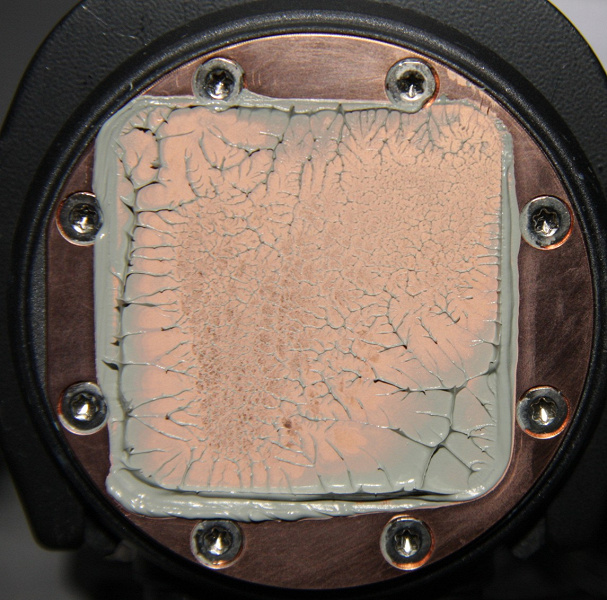
The situation is about the same. (The thermal paste distribution, of course, changed slightly when the processor and pump were separated.)
The body of the water block is made of hard black plastic. A lid made of similar plastic is fixed on top of the case, in which there are inserts made of transparent plastic with a smooth surface. On the inside, these inserts are coated with a thin mirror coating, which makes them translucent mirrors, and on the central triangular insert there is an inverted pattern in the form of the manufacturer’s logo. Below these inserts are independently controlled addressable RGB LEDs. The cover rotates 270 degrees, which in most cases will allow you to set the logo in the correct orientation.

The water block is relatively small – the maximum case diameter is 67 mm, and the height from the base of the heat sink is 48 mm. The length of the backlight cable is 40 cm and another 10 cm of the cable to the feed-through connector.
The hoses are 40 cm long (relatively long, which expands the installation possibilities), the external diameter of the hoses is approximately 13 mm. The hoses are encased in a slippery synthetic sheath. The L-shaped fittings at the inlet to the pump rotate, which makes it easy to install the system.
The radiator is made of aluminum and has a relatively durable black matte finish on the outside.
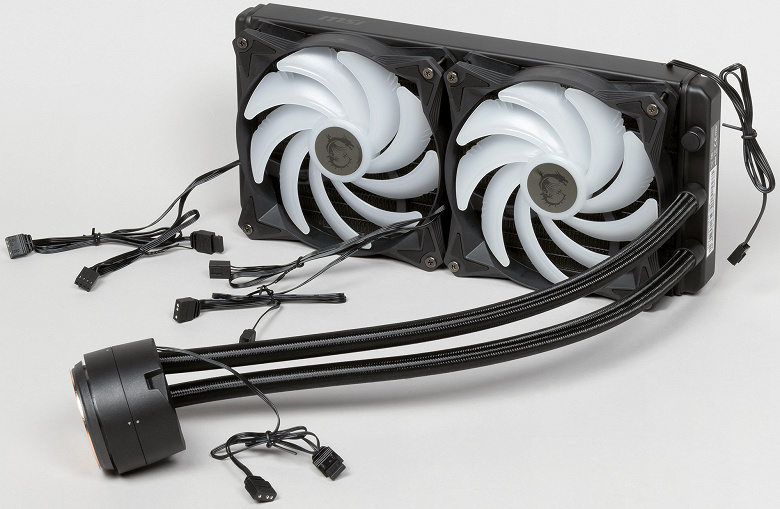
The measured dimensions of the radiator: length – 312 mm, width – 140 mm and thickness 27 mm.
The pump is integrated into one block with a radiator, which is very unusual.

The manufacturer claims that this solution reduces the noise from the pump and, since it is removed from heat sources, prolongs its service life. You can believe in the second, and the first may depend on how the system is mounted – the radiator is usually mounted on the outer panels of the case, so the pump may be closer to the user’s ears than if it were mounted on a water block. The length of the pump cable from the heatsink to the fan connector on the motherboard is 49 cm. The heatsink is divided into three zones. Through the channels of the two outer zones, the heated refrigerant passes from the inlet pipe to the opposite end of the radiator, and through the channels of the central zone it goes first to the pump, and then to the outlet pipe. The thermal image confirms this:
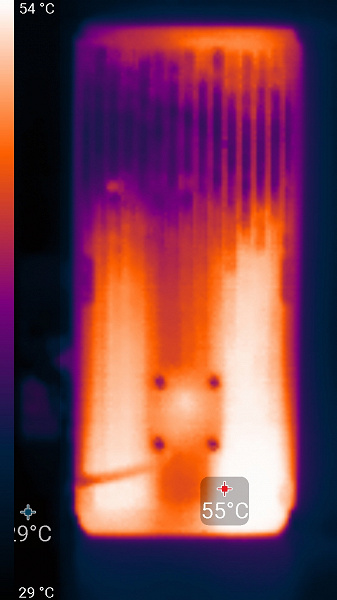
It is unlikely that such a device increases the efficiency of the radiator, since the cooled flow is slightly heated on both sides by the refrigerant supplied to the radiator.
Rubber pads are glued to the corners of the fan frame. These elastic elements should theoretically reduce vibration noise, but in practice this will not happen, since the mass of the fan and the rigidity of the vibration damping elements make it possible to reasonably assume that, due to the high resonant frequency, this system will not have any significant effect anyway. anti-vibration properties. In addition, the screws are in direct contact with the fan frame, that is, the connection is rigid, and any vibration from the fan is transmitted to the radiator.

The fan uses two ball bearings, good or bad – it’s not obvious, since the life of the bearing depends on the quality of manufacture, and not on the type. The length of the power cable is 35 cm. To connect both fans to one connector, you can use the included splitter with two 20 cm taps. Only these taps are enclosed in a braided sheath made of slippery plastic, all other cables are simply flat, which increases ease of installation.
The fan impeller is made of white translucent plastic and slightly frosted on the outside. The fan stator has RGB LEDs that illuminate the impeller from the inside. The length of the backlight cable from the fan is 55 cm, and another 10 cm to the pass-through connector. The pin contacts on the feed-through connectors are closed with plastic plugs. A three-wire addressable RGB backlight is used. The backlight cables from the waterblock and fans can be daisy-chained and plugged into the same three-pin backlight header on the motherboard or another controller.

The video below demonstrates the operation of the backlight (connection to an external controller, default mode):
The fasteners are made mainly of hardened steel and have a durable galvanized or semi-gloss black paint finish. Note that the mounting frame is simply inserted into the grooves on the pump, which is very convenient.
The system assembly with fasteners for LGA 2011 has a mass of 1298 g.
Testing
A full description of the testing methodology is given in the corresponding article ” Testing methodology for processor coolers of the 2020 sample “. For the load test, the powerMax (AVX) program was used, all cores of the Intel Core i9-7980XE processor worked at a fixed frequency of 3.2 GHz (multiplier 32). In all tests, unless otherwise noted, the pump runs on 12V.
Determination of the dependence of the cooler fan speed on the PWM duty cycle and / or supply voltage
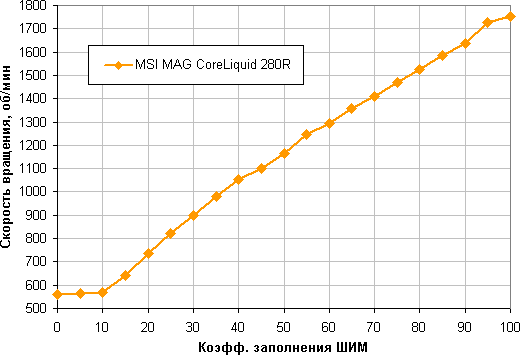
The rotation speed adjustment range is wide; Note that at 0% short circuit, the fans do not stop, which can be important in a hybrid cooling system with passive mode at minimum load.

Changing the speed of rotation is also smooth, but the range of adjustment with voltage is slightly wider. Fans stop at 1.6V and start at 2.1/2.7V. If necessary, they can be connected to 5 V.
We also give the dependence of the pump rotation speed on the supply voltage:
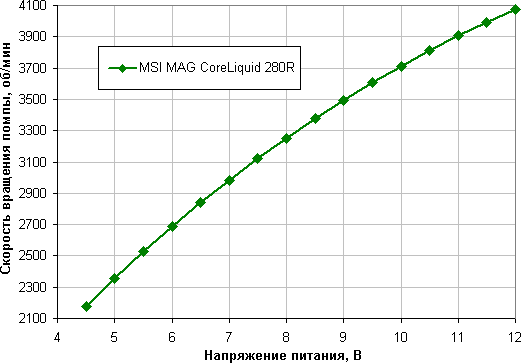
We note a smooth increase in the speed of rotation of the pump with an increase in the supply voltage. The pump stops at 4.0V and starts at 4.5V. It can also be connected to 5V.
Determination of the dependence of the temperature of the processor at its full load on the speed of rotation of the cooler fans

In this test, our processor with a TDP of 140 W does not overheat (at 24 degrees of ambient air) even at the minimum fan speeds achieved by changing the short circuit.
Determining the noise level depending on the speed of rotation of the cooler fans
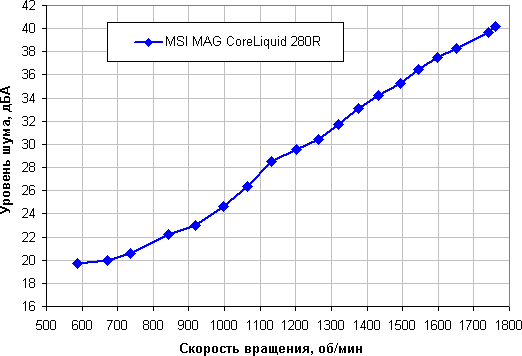
It depends, of course, on individual characteristics and other factors, but somewhere from 40 dBA and above, the noise is, from our point of view, very high for a desktop system; from 35 to 40 dBA, the noise level is classified as tolerable; below 35 dBA, the noise from the cooling system will not stand out much against the background of typical non-noisy PC components – case fans, fans on the power supply and on the video card, as well as hard drives; and somewhere below 25 dBA the cooler can be called conditionally silent. In this case, the entire specified range is covered, that is, depending on the fan speed, the system can be both noisy and very quiet. The noise from the pump alone is 17.6 dBA. The pump is very quiet, so there is not much point in reducing the noise by reducing the pump supply voltage. The background level was equal to 16.3 dBA (conditional value, which shows the sound level meter).
Plotting the dependence of the noise level on the temperature of the processor at full load

Plotting the dependence of the real maximum power on the noise level
Let’s try to get away from the conditions of the test bench to more realistic scenarios. Let’s say that the temperature of the air taken in by the cooling system fans can rise to 44 ° C (a realistic scenario when the fans on the radiator are set to blow out of the case in which the powerful video card is running), but the temperature of the processor under maximum load does not want to increase above 80 ° C. Restricting ourselves to these conditions, let’s plot the dependence of the real maximum power, denoted as P max (previously, we used the designation Max. TDP ), consumed by the processor, on the noise level ( details are described in the methodology ):
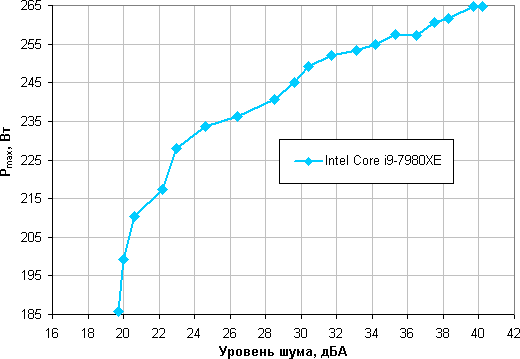
Taking 25 dBA as a criterion for conditional noiselessness, we get the approximate maximum power of processors corresponding to this level, which is about 235 watts. If you do not pay attention to the noise level, the power limits can be increased somewhere else up to 265 watts. Let us clarify once again that in harsh conditions of blowing the radiator with air heated to 44 degrees, when the air temperature drops, the indicated power limits for silent operation and maximum power increase.
Comparison with other LSS when cooling the Intel Core i9-7980XE processor
Using this link , you can calculate the power limits for other boundary conditions (air temperature and maximum processor temperature) and compare this system with several other LSSs tested using the same methodology (the list is updated). As you can see, the efficiency of this system is average and is at the level of typical LSS with a radiator for two 120 mm fans.
Testing on an AMD Ryzen 9 3950X processor
As an additional test, we decided to see how this coolant will cope with the cooling of the AMD Ryzen 9 3950X . The processors of the Ryzen 9 family are assemblies of three crystals under one cover. On the one hand, increasing the area from which heat is removed can improve the cooling capacity of the cooler, but on the other hand, the design of most coolers is optimized for better cooling of the central area of the processor.
The dependence of the temperature of the processor at its full load on the speed of rotation of the fans:
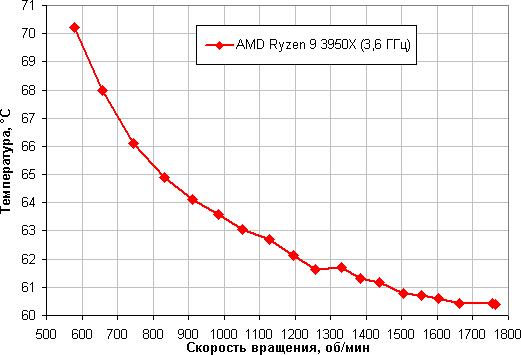
In fact, under test conditions, this processor does not overheat at 24 degrees of ambient air even at a short circuit of 10% (for this CPU, heating up to 95 degrees is allowed).
The dependence of the noise level on the temperature of the processor at full load:

Restricting ourselves to the above conditions, we plot the dependence of the real maximum power (denoted as P max ) consumed by the processor on the noise level:
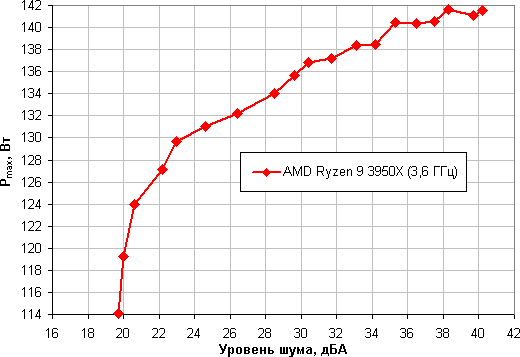
Taking 25 dBA as a conditional noiselessness criterion, we get that the maximum processor power corresponding to this level is about 130 W. If you do not pay attention to the noise level, then the power limit can be increased, but only somewhere up to 140 watts. Once again, we will clarify: this is in harsh conditions of blowing the radiator with air heated to 44 degrees. As the air temperature drops, the specified power limits for quiet operation and maximum power increase. The result is noticeably worse than in the case of the Intel Core i9-7980XE processor. However, provided there is enough good ventilation in the case, this cooler will quite cope with the cooling of the AMD Ryzen 9 3950X processor, but you should not count on the possibility of significant overclocking.
Comparison with other coolers and coolers when cooling the AMD Ryzen 9 3950X processor
You can use this link to calculate power limits for other boundary conditions (air temperature and maximum processor temperature).
findings
Based on the MSI MAG CoreLiquid 280R liquid cooling system, you can create a conditionally silent computer equipped with an Intel Core i9-7980XE (Intel LGA2066, Skylake-X (HCC)) type processor with a heat dissipation of about 235 W maximum, and this is even taking into account the possible increase in temperature inside enclosures up to 44 °C and subject to long-term maximum load. In the case of the AMD Ryzen 9 3950X chiplet processor, the cooler efficiency is noticeably lower, and in order to comply with the above conditions, the maximum power consumed by the processor should not exceed 130 watts. With lower cooling air temperatures and/or less stringent noise requirements, the power limits can be increased. Addressable multi-zone RGB illumination of the pump and fans will help decorate the interior of the system unit. We note good workmanship, convenient water block mounting, hose braiding, and the fact that the backlight allows the use of a controller compatible with a three-wire ARGB system, or it can be connected to a suitable connector on the motherboard.




